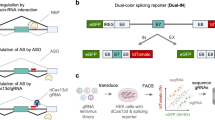Abstract
The TrkA NGF receptor extracellular region contains three leucine repeats flanked by cysteine clusters and two immunoglobulin-like domains that are required for specific ligand binding. Deletion of the immunoglobulin-like domains abolishes NGF binding and causes ligand independent activation of the receptor. Here we report a specific mutation that increases the binding affinity of the TrkA receptor for NGF. A change of proline 203 to alanine (P203A) in the linker region between the leucine repeats and the first Ig-like domain increased NGF binding by decreasing the ligand rate of dissociation. This mutated receptor was appropriately expressed on the cell surface and promoted ligand-independent neurite outgrowth in PC12nnr5 cells. The mutant receptor was capable of spontaneous dimerization and was constitutively phosphorylated in the absence of ligand. Moreover, expression of TrkA-P203A receptor in fibroblasts induced DNA synthesis and transformation and generated tumours in nude mice. These data suggest that domains outside of the immunoglobulin-like structure contribute to ligand binding and constitutive activation of Trk receptors.
This is a preview of subscription content, access via your institution
Access options
Subscribe to this journal
Receive 50 print issues and online access
$259.00 per year
only $5.18 per issue
Buy this article
- Purchase on Springer Link
- Instant access to full article PDF
Prices may be subject to local taxes which are calculated during checkout




Similar content being viewed by others
References
Arevalo JC, Conde B, Hempstead BL, Chao MV, Martin-Zanca D and Perez P. . 2000 Mol. Cell. Biol. 20: 5908–5916.
Barbacid M. . 1995 Curr. Opin. Cell Biol. 7: 148–155.
Blechman JM, Lev S, Barg J, Eisenstein M, Vaks B, Vogel Z, Givol D and Yarden Y. . 1995 Cell 80: 103–113.
Chao MV. . 2000 J. Neurosci. Res. 59: 353–355.
Coulier F, Kumar R, Ernst M, Klein R, Martin-Zanca D and Barbacid M. . 1990 Mol. Cell. Biol. 10: 4202–4210.
Cunnigham ME and Greene LA. . 1998 EMBO J. 17: 7282–7293.
Eng C and Mulligan LM. . 1997 Hum. Mutat. 9: 97–109.
Ezoe K, Holmes SA, Ho L, Bennett CP, Bolognia JL, Brueton L, Burn J, Falabella R, Gatto EM, Issii N, et al. . 1995 Am. J. Hum. Gen. 56: 58–66.
Greco A, Miranda C, Pagliardini S, Fusetti L, Bongarzone I and Pierotti MA. . 1997 Genes Chromosomes Cancer 19: 112–123.
Greco A, Fusetti L, Miranda C, Villa R, Zanotti S, Pagliardini S and Pierotti MA. . 1998 Oncogene 16: 809–816.
Green SH, Rydel RE, Connolly JL and Greene LA. . 1986 J. Cell Biol. 102: 830–843.
Holden PH, Asopa V, Robertson AGS, Clarke AR, Tyler S, Bennett GS, Brain SD, Wilcock GK, Allen SJ, Smith SKF and Dawbarn D. . 1997 Nature Biotechnol. 15: 668–672.
Kaplan DR and Miller FD. . 2000 Curr. Opin. Neurobiol. 10: 381–391.
Lewin GR and Barde YA. . 1996 Ann. Rev. Neurosci. 19: 289–317.
MacDonald JIS and Meakin SO. . 1996 Mol. Cell. Neurosci. 7: 371–390.
Muenke M, Schell U, Hehr A, Robin NH, Losken HW, Schinzel A, Pulleyn LJ, Rutland P, Reardon W, Malcolm S and Winter RM. . 1994 Nature Genet. 8: 269–274.
Naski MC and Ornitz DM. . 1998 Front. Biosci. 3: 781–794.
Neilson KM and Friesel R. . 1996 J. Biol. Chem. 271: 25049–25057.
Ninkina N, Grashchuck M, Buchman VL and Davies AM. . 1997 J. Biol. Chem. 272: 13019–13025.
Omura T, Heldin CH and Ostman . 1997 J. Biol. Chem. 272: 12676–12682.
Perez P, Coll PM, Hempstead BL, Martin-Zanca D and Chao MV. . 1995 Mol. Cell. Neurosci. 6: 97–105.
Plotnikov AN, Hubbard SR, Schlessinger J and Mohammadi M. . 2000 Cell 101: 413–424.
Plotnikov AN, Schlessinger J, Hubbard SR and Mohammadi M. . 1999 Cell 98: 641–650.
Porter AC and Vaillancourt RR. . 1998 Oncogene 16: 1343–1352.
Robertson SC, Tynan JA and Donoghue DJ. . 2000 Trends Genet. 16: 265–271.
Schneider R and Schweiger M. . 1991 Oncogene 6: 1807–1811.
Siegel PM and Muller WJ. . 1996 Proc. Natl. Acad. Sci. USA 93: 8878–8883.
Smith DK and Xue H. . 1997 J. Mol. Biol. 274: 530–545.
Stauber DJ, DiGabriele AD and Hendrickson WA. . 2000 Proc. Natl. Acad. Sci. USA 97: 49–54.
Urfer R, Tsoulofas P, O'Conell L, Shelton DL, Parada LF and Presta LG. . 1995 EMBO J. 14: 2795–2805.
Van Daalen Wetters T, Hawkins SA, Roussel MF and Sherr CJ. . 1992 EMBO J. 11: 551–557.
Wiesmann C, Ultsch MH, Bass SH and de Vos AM. . 1999 Nature 401: 184–188.
Wilkie AOM, Slaney SF, Oldrigde M, Poole MD, Ashworth GJ, Hockley AD, Hayward RD, David DJ, Pulleyn L and Rutland P. . 1995 Nature Genet. 9: 165–172.
Windish JM, Marksteiner R, Lang ME, Auer B and Schneider R. . 1995a Biochemistry 34: 11256–11263.
Windish JM, Marksteiner R and Schneider R. . 1995b J. Cell Biol. 270: 28133–28138.
Acknowledgements
This work was supported by grants from the Fundacion Ramon Areces and the European Union Program BIO4-CT96-0285. JC Arevalo was a recipient of fellowships from those grants. Grant support for MV Chao and BL Hempstead were from the NIH.
Author information
Authors and Affiliations
Rights and permissions
About this article
Cite this article
Arevalo, J., Conde, B., Hempstead, B. et al. A novel mutation within the extracellular domain of TrkA causes constitutive receptor activation. Oncogene 20, 1229–1234 (2001). https://doi.org/10.1038/sj.onc.1204215
Received:
Revised:
Accepted:
Published:
Issue Date:
DOI: https://doi.org/10.1038/sj.onc.1204215
Keywords
This article is cited by
-
Molecular basis of VEGFR1 autoinhibition at the plasma membrane
Nature Communications (2024)
-
Revisiting NTRKs as an emerging oncogene in hematological malignancies
Leukemia (2019)
-
NTRK fusion-positive cancers and TRK inhibitor therapy
Nature Reviews Clinical Oncology (2018)
-
Small-molecule modulation of neurotrophin receptors: a strategy for the treatment of neurological disease
Nature Reviews Drug Discovery (2013)
-
Neurotrophins and their receptors: A convergence point for many signalling pathways
Nature Reviews Neuroscience (2003)



